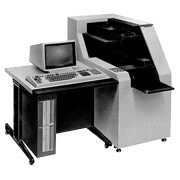Mitsubishi Electric announced the M2483-N OCR unit as a higher-end model to the M2483 in March 1981. The M2483-N came with a 14-inch display and a 1 MB flexible disk drive along with enhanced editing functions and improved usability and functionality.
The M2483-N optical character reader had the following features:
- The 14-inch display displayed headings, tables, and data as an image of the input form, making corrections and changes to input data easier. Enhanced data editing functions, such as duplicating read data and emitting stored data (loading fixed data), simplified entry data and reduced the work of operators.
- On previous models, unreadable character patterns were directly displayed on the display with hardware, but on the M2483-N unreadable character patterns were written and stored in system memory. This freed the machine from having to suspending reading operations while displaying an unreadable character pattern. Throughputs were improved because reading input forms and correcting unreadable characters could be done in parallel.
- Mitsubishi Electric developed a near-infrared fluorescent light with a peak spectrum of 740 nm, allowing many more dropout colors to be used. In addition to the previous red, pink, magenta, and orange, now purple, violet, sepia, brown, blue, and green could be used as the dropout color.
- Due to advances in LSI technology, the company was able to simplify the scanning mechanism, which previous used four 512-bit line image sensors, and use just one 2048-bit image sensor. This sensor increased the lens’s field of vision by four times and reduced the pixel pitch of the image sensor by about half, so that Mitsubishi Electric could develop a high-performance lens with a focal length of 35 mm, a magnification ratio of 0.1, an angle of view of 40 degrees, a peripheral light ratio of better than 70 percent, and distortion under ±0.1 percent, and a high-performance optical system to make use of the lens’s performance.
- The M2483 could read forms with 81 fields per line, making it easier to input programs and design data, in addition to ordinary data.
| Format | Page forms (reads multiple lines) | ||
|---|---|---|---|
| Forms | Sizes | Normal forms | 89 x 89 to 297 x 305 mm |
| 81-field forms | 297 x 420 mm | ||
| Thicknesses | Paper weight of 70 to 110 kilograms | ||
| Paper | OCR paper, high-grade paper (brand specified) | ||
| Readable characters | Handwritten characters | Ordinary handwritten numbers, letters, kana characters, and symbols (26 types) | |
| Printed characters | JIS OCR-B numbers, letters, and symbols (24 types) | ||
| Old OCR-B numbers, letters, and symbols (21 types) | |||
| JIS OCR-K kana characters | |||
| 407 font numbers | |||
| Dot-matrix numbers | |||
| Multi-font numbers (JIS OCR-B, old JIS OCR-B, 407) | |||
| Marks | |||
| No. of readable characters | Normal forms | Handwritten characters | Up to 54 characters per line |
| Printed characters | Up to 96 characters per line | ||
| 81-field forms | 81 characters per line | ||
| No. of readable lines | Normal forms | Up to 40 lines (1/3 inch pitch) | |
| 81-field forms | 25 lines | ||
| Read speeds | Normal forms | Up to 37 sheets per minute | |
| 81-field forms | Average card equivalent speed of 50 sheets per minute | ||
| Hopper capacity | 300 sheets | ||
| Stacker capacity | Accept stacker: 300 sheets Reject stacker: 300 sheets |
||
| Power supply | 100 VAC ±10%, 50 / 60 Hz, 1.0 kVA (standard configuration) | ||
| Dimensions | 1,500 x 1,270 x 1,170 mm (w x d x h) | ||
| Output devices | Standard: Flexible disks (1 MB) Optional: Magnetic tape (JIS 8-bit / EBCDIC, 800 / 1,600 BPI) Paper tape (JIS 7-bit + 1 parity bit, 60 characters per second) Card punch (26 ± 2 cards per minute) Communication line (1,200 to 4,800 BPS, BSC protocol) |
||


